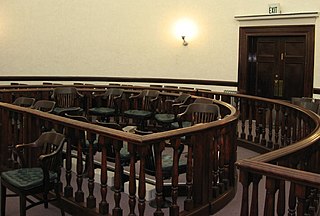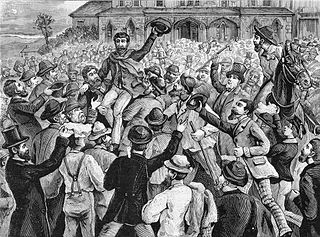Related Research Articles

A jury is a sworn body of people (jurors) convened to hear evidence, make findings of fact, and render an impartial verdict officially submitted to them by a court, or to set a penalty or judgment.
In a legal dispute, one party has the burden of proof to show that they are correct, while the other party has no such burden and is presumed to be correct. The burden of proof requires a party to produce evidence to establish the truth of facts needed to satisfy all the required legal elements of the dispute.
Judgment notwithstanding the verdict, also called judgmentnon obstante veredicto, or JNOV, is a type of judgment as a matter of law that is sometimes rendered at the conclusion of a jury trial.
Jury nullification (US/UK), jury equity (UK), or a perverse verdict (UK) occurs when the jury in a criminal trial gives a not guilty verdict regardless of whether they believe a defendant has broken the law. The jury's reasons may include the belief that the law itself is unjust, that the prosecutor has misapplied the law in the defendant's case, that the punishment for breaking the law is too harsh, or general frustrations with the criminal justice system. Some juries have also refused to convict due to their own prejudices in favor of the defendant. Such verdicts are possible because a jury has an absolute right to return any verdict it chooses.

In common law jurisdictions, an acquittal means that the prosecution has failed to prove that the accused is guilty beyond a reasonable doubt of the charge presented. It certifies that the accused is free from the charge of an offense, as far as criminal law is concerned. The finality of an acquittal is dependent on the jurisdiction. In some countries, such as the United States, an acquittal prohibits the retrial of the accused for the same offense, even if new evidence surfaces that further implicates the accused. The effect of an acquittal on criminal proceedings is the same whether it results from a jury verdict or results from the operation of some other rule that discharges the accused. In other countries, like Australia and the UK, the prosecuting authority may appeal an acquittal similar to how a defendant may appeal a conviction — but usually only if new and compelling evidence comes to light or the accused has interfered with or intimidated a juror or witness.

In law, a verdict is the formal finding of fact made by a jury on matters or questions submitted to the jury by a judge. In a bench trial, the judge's decision near the end of the trial is simply referred to as a finding. In England and Wales, a coroner's findings used to be called verdicts but are, since 2009, called conclusions.
Nolle prosequi, abbreviated nol or nolle pros, is legal Latin meaning "to be unwilling to pursue". It is a type of prosecutorial discretion in common law, used for prosecutors' declarations that they are voluntarily ending a criminal case before trial or before a verdict is rendered; it is a kind of motion to dismiss and contrasts with an involuntary dismissal.
Beyond (a) reasonable doubt is a legal standard of proof required to validate a criminal conviction in most adversarial legal systems. It is a higher standard of proof than the standard of balance of probabilities commonly used in civil cases because the stakes are much higher in a criminal case: a person found guilty can be deprived of liberty or, in extreme cases, life, as well as suffering the collateral consequences and social stigma attached to a conviction. The prosecution is tasked with providing evidence that establishes guilt beyond a reasonable doubt in order to get a conviction; albeit prosecution may fail to complete such task, the trier-of-fact's acceptance that guilt has been proven beyond a reasonable doubt will in theory lead to conviction of the defendant. A failure for the trier-of-fact to accept that the standard of proof of guilt beyond a reasonable doubt has been met thus entitles the accused to an acquittal. This standard of proof is widely accepted in many criminal justice systems, and its origin can be traced to Blackstone's ratio, "It is better that ten guilty persons escape than that one innocent suffer."

Woolmington v DPP [1935] AC 462 is a landmark House of Lords case, where the presumption of innocence was re-consolidated.

The criminal law of Canada is under the exclusive legislative jurisdiction of the Parliament of Canada. The power to enact criminal law is derived from section 91(27) of the Constitution Act, 1867. Most criminal laws have been codified in the Criminal Code, as well as the Controlled Drugs and Substances Act, Youth Criminal Justice Act and several other peripheral statutes.
In the English law of homicide, manslaughter is a less serious offence than murder, the differential being between levels of fault based on the mens rea or by reason of a partial defence. In England and Wales, a common practice is to prefer a charge of murder, with the judge or defence able to introduce manslaughter as an option. The jury then decides whether the defendant is guilty or not guilty of either murder or manslaughter. On conviction for manslaughter, sentencing is at the judge's discretion, whereas a sentence of life imprisonment is mandatory on conviction for murder. Manslaughter may be either voluntary or involuntary, depending on whether the accused has the required mens rea for murder.

Trimarco v. Klein Ct. of App. of N.Y., 56 N.Y.2d 98, 436 N.E.2d 502 (1982) is a 1982 decision by the New York Court of Appeals dealing with the use of custom in determining whether a person acted reasonably given the situation. It is commonly studied in introductory U.S. tort law classes.
Apodaca v. Oregon, 406 U.S. 404 (1972), was a United States Supreme Court case in which the Court held that state juries may convict a defendant by a less-than-unanimous verdict in a felony criminal case. The four-justice plurality opinion of the court, written by Justice White, affirmed the judgment of the Oregon Court of Appeals and held that there was no constitutional right to a unanimous verdict. Although federal law requires federal juries to reach criminal verdicts unanimously, the Court held Oregon's practice did not violate the Sixth Amendment right to trial by jury and so allowed it to continue. In Johnson v. Louisiana, a case decided on the same day, the Court held that Louisiana's similar practice of allowing criminal convictions by a jury vote of 9–3 did not violate due process or equal protection under the Fourteenth Amendment.
No case for the defendant to answer is a term in the criminal law of some Commonwealth states, whereby a defendant seeks acquittal without having to present a defence, because of the insufficiency of the prosecution's case. The motion is infrequently used in civil cases where the defendant asserts that the plaintiff's case is insufficient to prove liability.
The Double Jeopardy Clause of the Fifth Amendment to the United States Constitution provides: "[N]or shall any person be subject for the same offence to be twice put in jeopardy of life or limb..." The four essential protections included are prohibitions against, for the same offense:
South African criminal law is the body of national law relating to crime in South Africa. In the definition of Van der Walt et al., a crime is "conduct which common or statute law prohibits and expressly or impliedly subjects to punishment remissible by the state alone and which the offender cannot avoid by his own act once he has been convicted." Crime involves the infliction of harm against society. The function or object of criminal law is to provide a social mechanism with which to coerce members of society to abstain from conduct that is harmful to the interests of society.
Criminal procedure in South Africa refers to the adjudication process of that country's criminal law. It forms part of procedural or adjectival law, and describes the means by which its substantive counterpart, South African criminal law, is applied. It has its basis mainly in English law.
R v Kewelram is an important case in South African law. It was heard in the Appellate Division, Bloemfontein, on 15 February 1922, with judgment handed down on 6 March. The judges were Innes CJ, Solomon JA, Maasdorp JA, De Villiers JA and Juta JA.

M v R or M v The Queen is an Australian legal case decided in the High Court. It is an important authority in the field of criminal law, for the circumstances in which it is permissible for a jury's guilty verdict to be overturned by a judge. The case involved an appeal against criminal conviction by a father, against allegations of sexual assault and rape by his daughter. His appeal was allowed by majority.
Johnson v. Louisiana, 406 U. S. 356 (1972), was a court case in the U.S. Supreme Court involving the Due Process Clause and Equal Protection Clause of the Fourteenth Amendment to the United States Constitution. The U.S. Supreme Court ruled that the Louisiana law that allowed less-than unanimous jury verdicts to convict persons charged with a felony, does not violate the Due Process clause. This case was argued on a similar basis as Apodaca v. Oregon.
References
Case law
- R v Kewelram 1922 AD 213.
- R v Shein 1925 AD 6.